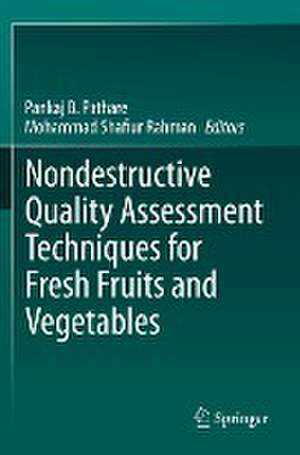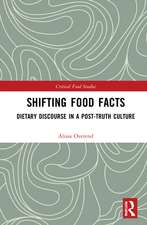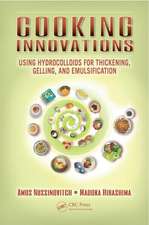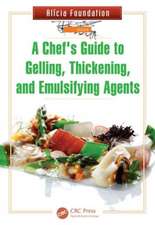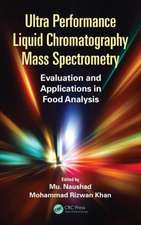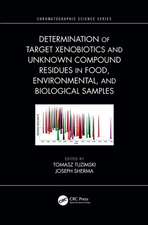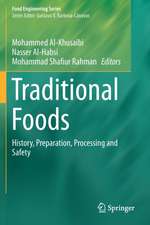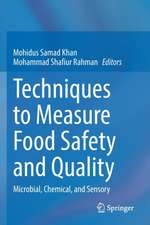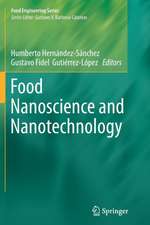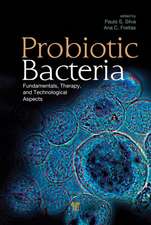Nondestructive Quality Assessment Techniques for Fresh Fruits and Vegetables
Editat de Pankaj B. Pathare, Mohammad Shafiur Rahmanen Limba Engleză Paperback – 18 noi 2023
The book presents the details of nondestructive approaches focusing on the present-day trends and existing future opportunities in the fresh food supply chain. First, it overviews different nondestructive techniques in food quality detection. Then it presents nondestructive methods: monochrome computer vision, imaging techniques, biospeckle laser technique, Fourier Transform Infrared (FTIR) Spectroscopy, hyperspectral imaging, Raman spectroscopy, near infrared (NIR) spectroscopy, X-ray computed tomography, ultrasound, acoustic emission, chemometrics, electronic nose and tongue. Selected applications of each method are also introduced. As a result, readers gain a better understanding of how to use nondestructive methods and technologies to detect the quality of fresh fruits and vegetables.
With a wide range of interesting topics, the book will benefit readers including postharvest & food scientists/technologists, industry personnel and researchers involved in fresh produce quality detection. The book can also serve as a readily accessible reference material for postgraduate students.
| Toate formatele și edițiile | Preț | Express |
|---|---|---|
| Paperback (1) | 1114.83 lei 6-8 săpt. | |
| Springer Nature Singapore – 18 noi 2023 | 1114.83 lei 6-8 săpt. | |
| Hardback (1) | 1120.14 lei 6-8 săpt. | |
| Springer Nature Singapore – 18 noi 2022 | 1120.14 lei 6-8 săpt. |
Preț: 1114.83 lei
Preț vechi: 1359.55 lei
-18% Nou
Puncte Express: 1672
Preț estimativ în valută:
213.33€ • 220.42$ • 177.46£
213.33€ • 220.42$ • 177.46£
Carte tipărită la comandă
Livrare economică 19 martie-02 aprilie
Preluare comenzi: 021 569.72.76
Specificații
ISBN-13: 9789811954245
ISBN-10: 9811954240
Pagini: 390
Ilustrații: XI, 390 p. 1 illus.
Dimensiuni: 155 x 235 mm
Greutate: 0.62 kg
Ediția:1st ed. 2022
Editura: Springer Nature Singapore
Colecția Springer
Locul publicării:Singapore, Singapore
ISBN-10: 9811954240
Pagini: 390
Ilustrații: XI, 390 p. 1 illus.
Dimensiuni: 155 x 235 mm
Greutate: 0.62 kg
Ediția:1st ed. 2022
Editura: Springer Nature Singapore
Colecția Springer
Locul publicării:Singapore, Singapore
Cuprins
Notă biografică
Dr. Pankaj Pathare is an Assistant Professor of Postharvest Technology at Sultan Qaboos University, Oman. He has graduated with a B. Tech degree (Agricultural Engineering) from Dr. Panjabrao Deshmukh Krishi Vidyapeeth, Akola (India), and PhD (Process & Chemical Engineering) from the University College Cork (Ireland). Before joining at SQU, he worked as researcher at Newcastle University, UK and Stellenbosch University, South Africa. He has gained expertise on postharvest technology & food engineering which includes quantification of Postharvest losses during transportation, Mechanical damage of perishables, Food agglomeration/granulation, Food drying and cooling and Structural design of corrugated packaging. The research results are well documented in 50 original scientific peer-reviewed journal papers. He also worked as supervisor/co-supervisor for ten postgraduate research students. He is a member of the editorial board of several research journals including PLoS ONE, Frontiers in Sustainable Food Systems, Open Agriculture, and Journal of Food Quality.
Prof. Shafiur Rahman is the author/co-author of over 450 technical articles including more than 160 journal papers and 15 books. He is the author of the internationally acclaimed and award-winning Food Properties Handbook, and editor of the popular Handbook of Food Preservation published by CRC Press, Florida. He has initiated the International Journal of Food Properties and serves as the founding Editor-in-Chief for more than 20 years. He serves on the editorial boards of 10 international journals and book series. He also serves as Editor-in-Chief for the Journal of Agricultural and Marine Sciences, published by Sultan Qaboos University. In 2008, Professor Rahman was ranked among the top five Leading Scientists and Engineers of 57 OIC Member Countries in the Agroscience Discipline. In 2020, he was recognized among World Top 2% influential scholars (ranked 107 among 48,454 food science researchers), published by Stanford University, USA.
Prof. Shafiur Rahman is the author/co-author of over 450 technical articles including more than 160 journal papers and 15 books. He is the author of the internationally acclaimed and award-winning Food Properties Handbook, and editor of the popular Handbook of Food Preservation published by CRC Press, Florida. He has initiated the International Journal of Food Properties and serves as the founding Editor-in-Chief for more than 20 years. He serves on the editorial boards of 10 international journals and book series. He also serves as Editor-in-Chief for the Journal of Agricultural and Marine Sciences, published by Sultan Qaboos University. In 2008, Professor Rahman was ranked among the top five Leading Scientists and Engineers of 57 OIC Member Countries in the Agroscience Discipline. In 2020, he was recognized among World Top 2% influential scholars (ranked 107 among 48,454 food science researchers), published by Stanford University, USA.
Textul de pe ultima copertă
This book describes the various techniques for nondestructive quality assessment of fruits and vegetables. It covers the methods, measurements, operation principles, procedures, data analysis, and applications for implementing these techniques.
The book presents the details of nondestructive approaches focusing on the present-day trends and existing future opportunities in the fresh food supply chain. First, it overviews different nondestructive techniques in food quality detection. Then it presents nondestructive methods: monochrome computer vision, imaging techniques, biospeckle laser technique, Fourier Transform Infrared (FTIR) Spectroscopy, hyperspectral imaging, Raman spectroscopy, near infrared (NIR) spectroscopy, X-ray computed tomography, ultrasound, acoustic emission, chemometrics, electronic nose and tongue. Selected applications of each method are also introduced. As a result, readers gain a better understanding of how to use nondestructive methods and technologies to detect the quality of fresh fruits and vegetables.
With a wide range of interesting topics, the book will benefit readers including postharvest & food scientists/technologists, industry personnel and researchers involved in fresh produce quality detection. The book can also serve as a readily accessible reference material for postgraduate students.
The book presents the details of nondestructive approaches focusing on the present-day trends and existing future opportunities in the fresh food supply chain. First, it overviews different nondestructive techniques in food quality detection. Then it presents nondestructive methods: monochrome computer vision, imaging techniques, biospeckle laser technique, Fourier Transform Infrared (FTIR) Spectroscopy, hyperspectral imaging, Raman spectroscopy, near infrared (NIR) spectroscopy, X-ray computed tomography, ultrasound, acoustic emission, chemometrics, electronic nose and tongue. Selected applications of each method are also introduced. As a result, readers gain a better understanding of how to use nondestructive methods and technologies to detect the quality of fresh fruits and vegetables.
With a wide range of interesting topics, the book will benefit readers including postharvest & food scientists/technologists, industry personnel and researchers involved in fresh produce quality detection. The book can also serve as a readily accessible reference material for postgraduate students.
Caracteristici
Presents diverse methods of nondestructive quality examination of fruits and vegetables
Introduces nondestructive, rapid, robust, environmental-friendly and accurate methods
Is informative for professionals in the fresh produce industry as well as for students, academics and engineers
Introduces nondestructive, rapid, robust, environmental-friendly and accurate methods
Is informative for professionals in the fresh produce industry as well as for students, academics and engineers
